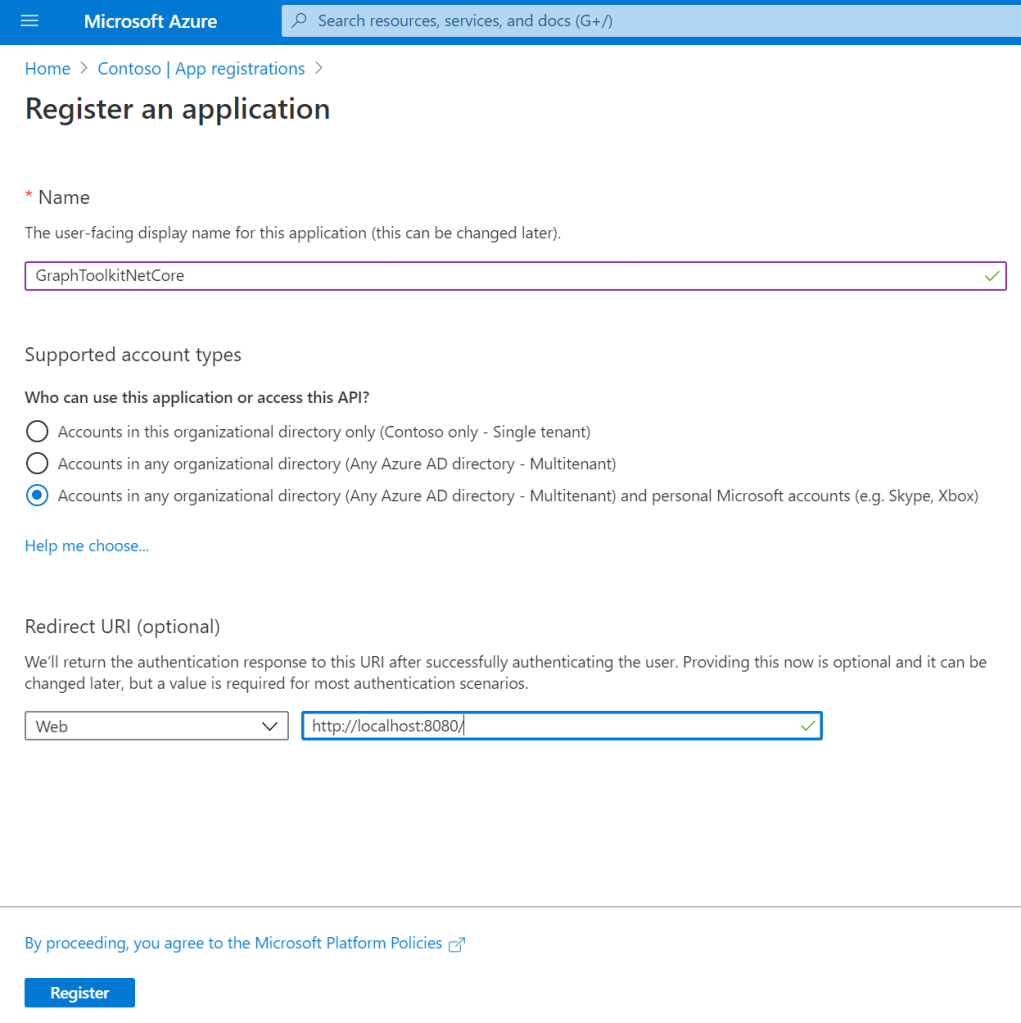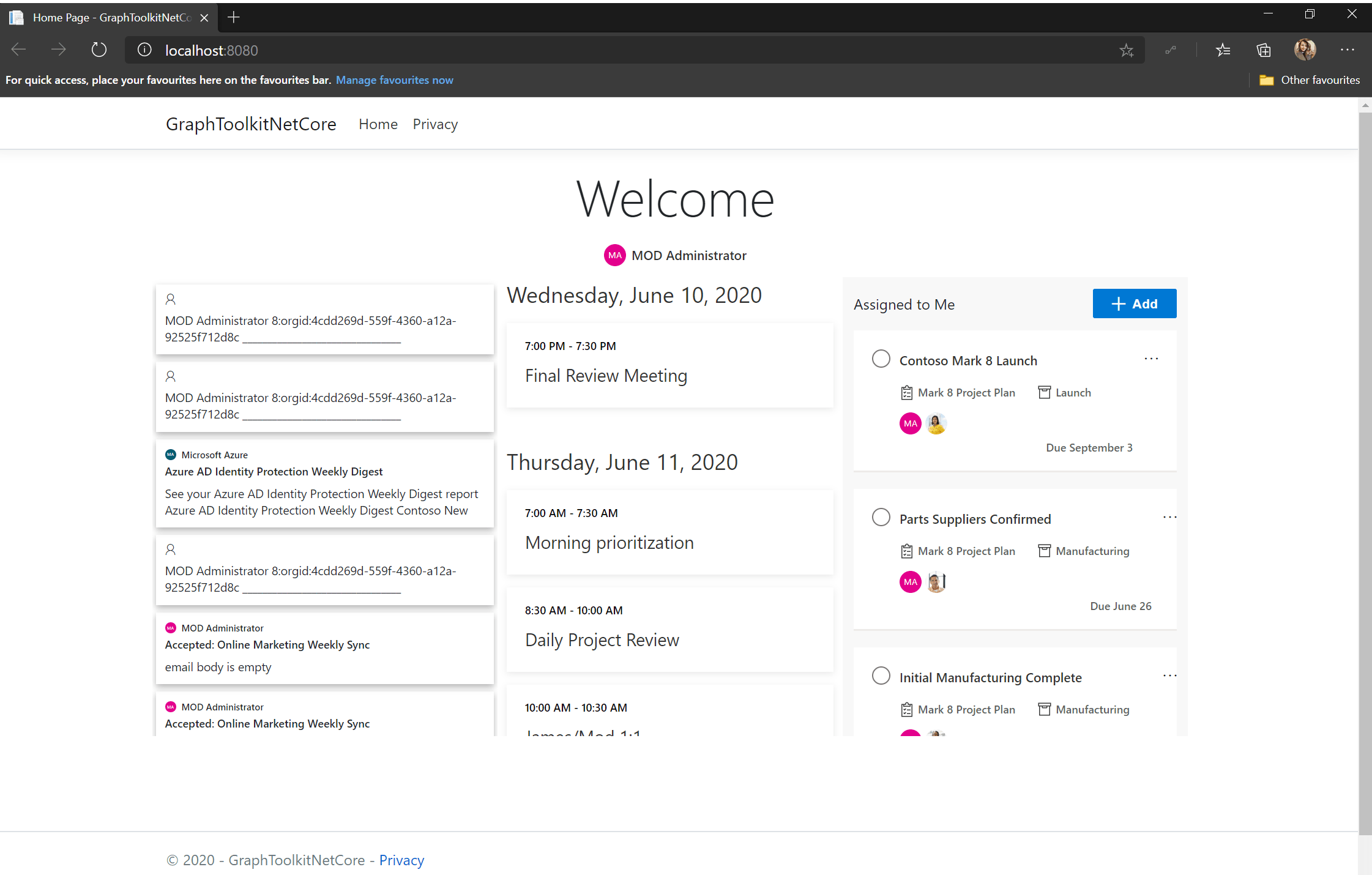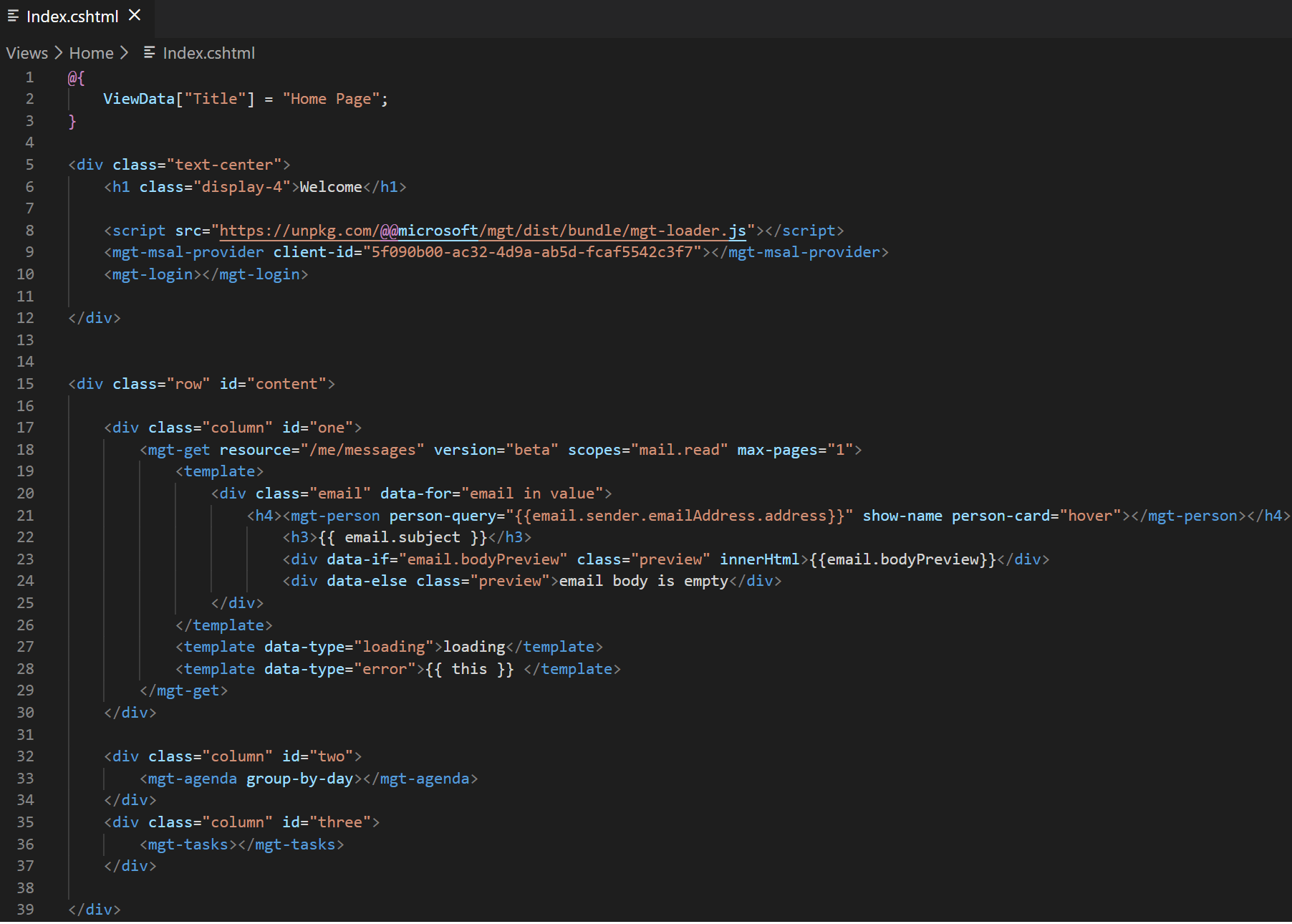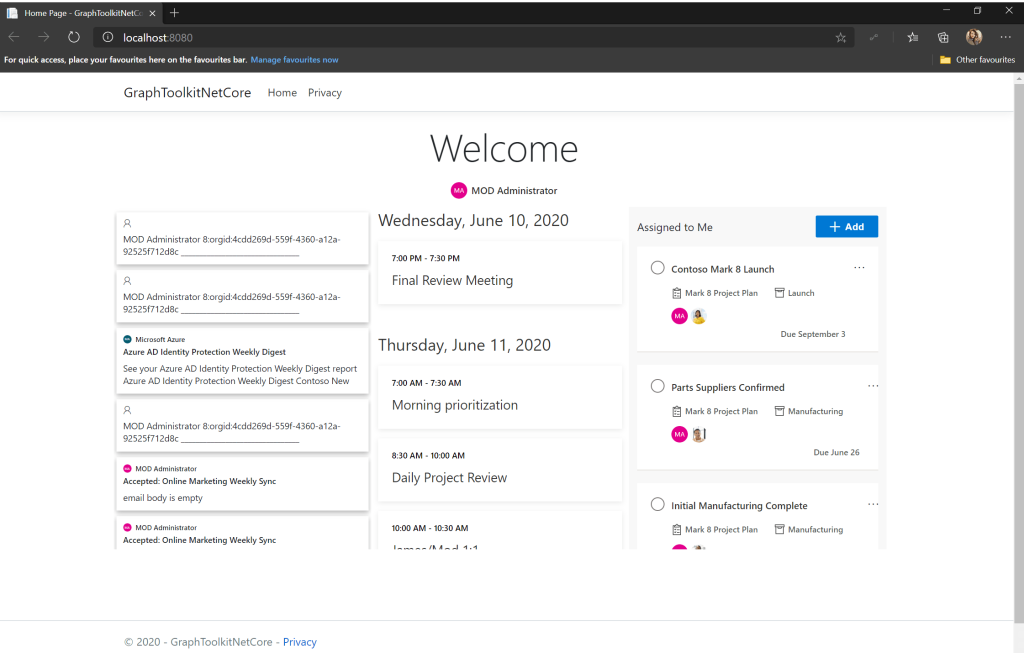Hello everyone! Today, we will work on building an ASP.NET Core MVC web app from scratch and use Microsoft Graph Toolkit to:
- Enable Microsoft identity platform authentication
- Get the agenda from Outlook Calendar
- Get tasks from Planner
- Get e-mails from Outlook
I am so excited about Microsoft Graph Toolkit, since the day it is announced. It is a powerful collection of reusable web components that enables accessing Outlook, Calendar, Tasks, People and many more with just couple lines of code! Believe it or not, Microsoft identity platform authentication can be implemented in seconds thanks to Microsoft Graph Toolkit.
This web app scenario will be a great example to understand how easy and fast to consume Microsoft Graph Toolkit components!
You can get the source code from https://github.com/aycabas/MicrosoftGraphToolkit-NetCore
Create ASP.NET Core MVC web app in Visual Studio Code
- Open the Terminal in Visual Studio Code (Ctrl+Shift+`)
- Create a new folder for the project
PS C:\Users\user> cd Desktop
PS C:\Users\user\Desktop> mkdir GraphToolkitNetCore
- Create ASP.NET Core MVC app
PS C:\Users\user\Desktop> dotnet new mvc
PS C:\Users\user\Desktop> cd GraphToolkitNetCore
- When the app is created successfully, go ahead and click on “Open Folder” to open your project folder

- Press F5 to run the project

- Our project is working fine. Before we start building our app with Microsoft Graph Toolkit, let’s go to launchSettings.json under Properties and set applicationUrl as “http://localhost:8080”

Register an app in Azure Active Directory
- Go to portal.azure.com
- Under Azure Active Directory, go to App Registration and click on New Registration

- Give a name to your app
- Choose the access level
- Choose Web and place http://localhost:8080 as a Redirect URI

- Go to Authentication tab
- Check Access tokens and ID tokens

- Finally, go to Overview tab
- Copy Application (client) ID to a notepad, we will need it later

Setup Index.cshtml
- Go to Index.cshtml and add a row and three columns inside the row
<div class="row" id="content">
<div class="column" id="one"></div>
<div class="column" id="two"></div>
<div class="column" id="three"></div>
</div>
- Copy below additional css to site.css under wwwroot>site.scs
/* Main content */
#content, html, body {
height: 98%;
}
#one {
float: left;
width: 33%;
background:transparent;
height:500px;
overflow: hidden;
}
#one:hover {
overflow-y: auto;
}
#two {
float: middle;
width: 33%;
background: transparent;
height: 500px;
overflow: hidden;
}
#two:hover {
overflow-y: auto;
}
#three {
float: left;
width: 33%;
background: transparent;
height: 500px;
overflow: hidden;
}
#three:hover {
overflow-y: auto;
}
/*Email*/
.email {
box-shadow: 0 3px 7px rgba(0, 0, 0, 0.3);
padding: 10px;
margin: 8px 4px;
font-family: Segoe UI, Frutiger, Frutiger Linotype, Dejavu Sans, Helvetica Neue, Arial, sans-serif;
}
.email:hover {
box-shadow: 0 3px 14px rgba(0, 0, 0, 0.3);
padding: 10px;
margin: 8px 4px;
}
.email h3 {
font-size: 12px;
margin-top: 4px;
}
.email h4 {
font-size: 10px;
margin-top: 0px;
margin-bottom: 0px;
}
.email mgt-person {
--font-size: 10px;
--avatar-size-s: 12px;
}
.email .preview {
font-size: 13px;
text-overflow: ellipsis;
word-wrap: break-word;
overflow: hidden;
max-height: 2.8em;
line-height: 1.4em;
}
a.navbar-brand {
white-space: normal;
text-align: center;
word-break: break-all;
}
Let’s start using with Microsoft Graph Toolkit
Login
- Go to Home>Index.cshtml
- Implement MSAL provider in your Index.cshtml to facilitate Microsoft identity platform authentication
- Make sure it is placed under the welcome message
<script src="https://unpkg.com/@@microsoft/mgt/dist/bundle/mgt-loader.js"></script>
<mgt-msal-provider client-id="[Client-id]"></mgt-msal-provider>
<mgt-login></mgt-login>

- Paste Application (client) ID that you copied earlier from Azure Active Directory

- Press F5 to run your application
- Click on sign in button and login with your account
- Accept to permission request


- When you successfully complete your authentication, you should see your details in the page

Get E-mails
- Use mgt-get to get user’s e-mails. Implement below code as column 1 in Index.cshtml
<mgt-get resource="/me/messages" version="beta" scopes="mail.read" max-pages="1">
<template>
<div class="email" data-for="email in value">
<h4><mgt-person person-query="{{email.sender.emailAddress.address}}" show-name person-card="hover"></mgt-person></h4>
<h3>{{ email.subject }}</h3>
<div data-if="email.bodyPreview" class="preview" innerHtml>{{email.bodyPreview}}</div>
<div data-else class="preview">email body is empty</div>
</div>
</template>
<template data-type="loading">loading</template>
<template data-type="error">{{ this }} </template>
</mgt-get>
- Press F5 to run the app, you should be able to see the emails

Agenda
- Use mgt-agenda to get a user or group calendar. Implement below code as column 2 in Index.cshtml
<mgt-agenda group-by-day></mgt-agenda>
- Press F5 to run the app, you should be able to see the agenda on the right side of the e-mails

Tasks
- Use mgt-tasks to get a user or group calendar. Implement below code as column 2 in Index.cshtml
<mgt-tasks></mgt-tasks>
- Press F5 to run the app, you should be able to see the tasks on the right side of the agenda

Final version of Index.cshtml will look like below:
@{
ViewData["Title"] = "Home Page";
}
<div class="text-center">
<h1 class="display-4">Welcome</h1>
<script src="https://unpkg.com/@@microsoft/mgt/dist/bundle/mgt-loader.js"></script>
<mgt-msal-provider client-id="[Client-id]"></mgt-msal-provider>
<mgt-login></mgt-login>
</div>
<div class="row" id="content">
<div class="column" id="one">
<mgt-get resource="/me/messages" version="beta" scopes="mail.read" max-pages="1">
<template>
<div class="email" data-for="email in value">
<h4><mgt-person person-query="{{email.sender.emailAddress.address}}" show-name person-card="hover"></mgt-person></h4>
<h3>{{ email.subject }}</h3>
<div data-if="email.bodyPreview" class="preview" innerHtml>{{email.bodyPreview}}</div>
<div data-else class="preview">email body is empty</div>
</div>
</template>
<template data-type="loading">loading</template>
<template data-type="error">{{ this }} </template>
</mgt-get>
</div>
<div class="column" id="two">
<mgt-agenda group-by-day></mgt-agenda>
</div>
<div class="column" id="three">
<mgt-tasks></mgt-tasks>
</div>
</div>

Finally, our app is ready! We have our e-mails, agenda and tasks in one place. I hope you enjoyed using Microsoft Graph Toolkit. You can get the source code from https://github.com/aycabas/MicrosoftGraphToolkit-NetCore/tree/master
Let me know about your experience or if you have any feedback!

Leave a Reply